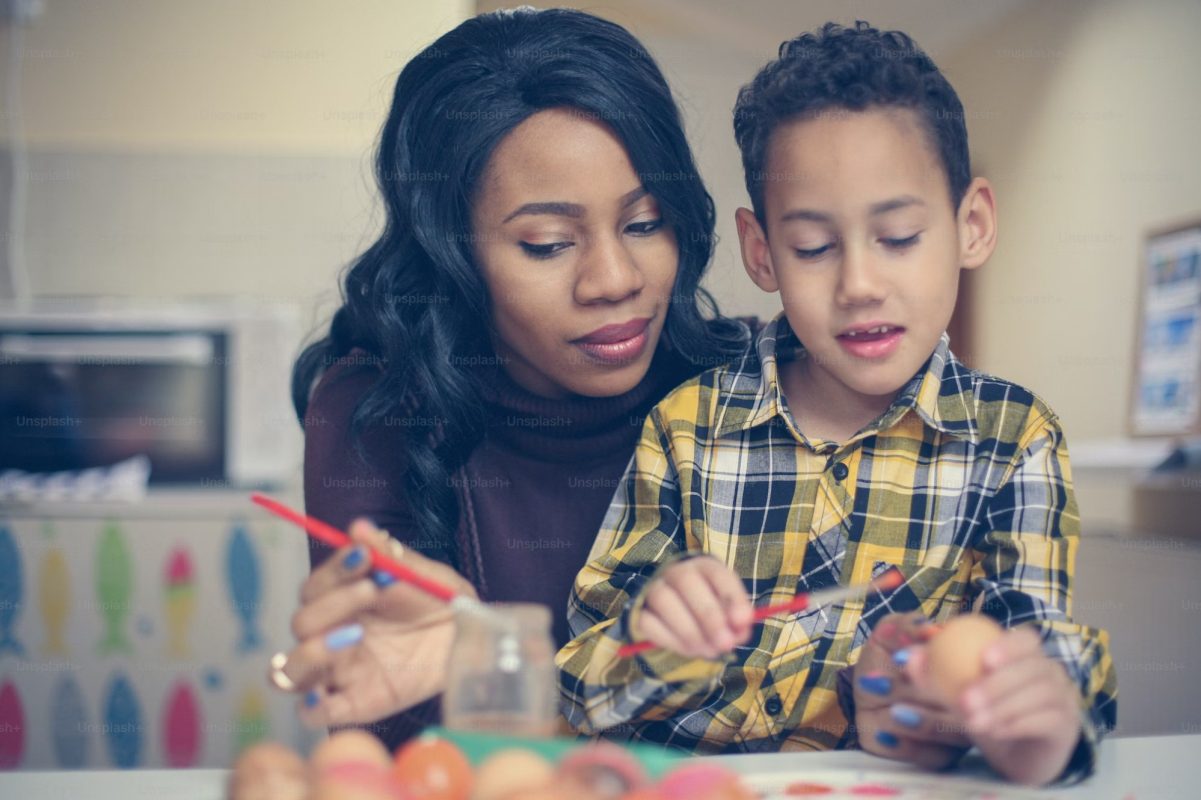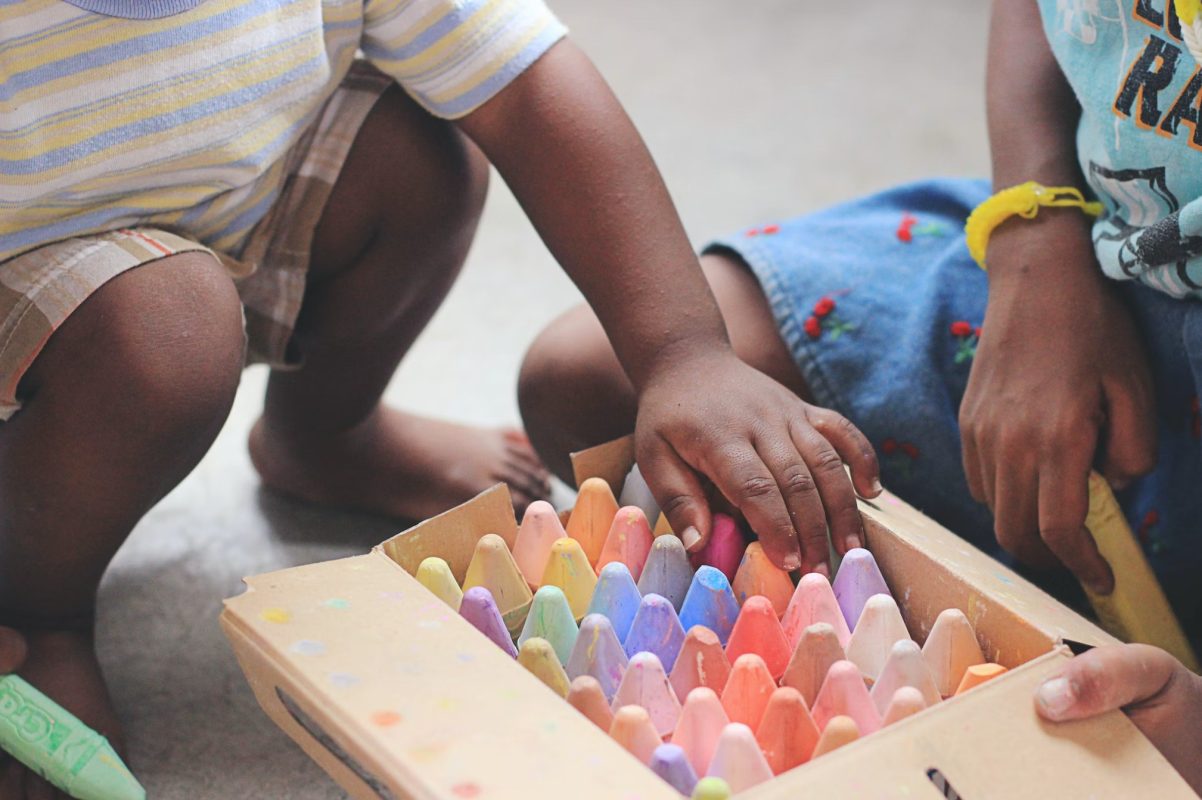Color blindness is a common condition that affects millions of people worldwide. A parent’s first concern when their child is diagnosed with color blindness is what impact this will have on their future education and development. Fortunately, there are many resources available to help parents navigate the process of raising a colorblind child into adulthood. In this post, we discuss why it’s important for parents to talk about color blindness with their children and how they can support them as they grow up in a world designed for people who see in full color
Understanding color blindness in children
Color blindness is a common issue that affects millions of people worldwide. It’s also a disorder that can be passed down through families, making it even more important to understand how your child’s vision works so you can help them succeed.
The most widely recognized form of color blindness is red-green deficiency, which occurs when someone has trouble distinguishing between the two colors or seeing shades of green easily compared to reds and yellows. This type of color deficiency is present in about 8 percent of men worldwide; women are less likely than men to have it because they have two X chromosomes instead of one X and one Y chromosome like males do (this difference means there are twice as many chances for mutations).
Some people have problems seeing some shades within either category but not others; there are other types as well–blue-yellow deficiencies are less common but still exist among those who suffer from this condition
Types of color blindness and their prevalence
There are three types of color blindness:
- Red-green color blindness, which is the most common. It affects about one in 10 men and one in 200 women. It occurs when the red or green cones in your eyes don’t work correctly, so you can’t see certain colors as well as someone who doesn’t have this form of color blindness.
- Blue-yellow color blindness, also known as deuteranopia (pronounced “deu-ter-AN-oh-pee-uh”), is less common than red-green but still affects about 1% of males and 0.1% females worldwide. People with this condition have difficulty distinguishing between reds/greens from blues/yellows because their green cones aren’t working properly; they may also see some blues as purple or gray instead of blue (because their blue cones aren’t working properly).
- Total color blindness–or being unable to distinguish any colors at all–is very rare: only 1 out of every 30 million people has total monochromacy (also called achromatopsia).
Common challenges faced by colorblind children

Colorblind children can have a hard time doing the things that other kids take for granted. They may struggle with finding clothes that match, getting lost on the way to school or sports practice, and reading maps, street signs and numbers.
With so many challenges in front of them, it’s important to know what your child needs from you as they grow up – and how best to support them along the way.
Communicating with your child’s school and teachers
If your child is colorblind, it’s important to inform their school of their challenges and ask for help. You should also request a 504 plan (more on this later) and accommodations or modifications so they can succeed in school.
When you meet with the teacher(s), make sure to explain what’s going on with your child’s vision and how it affects their ability to see colors. The more information you can give them about his or her specific needs, the better equipped they’ll be to provide appropriate support for him/her at school!
If possible, bring along some examples of things that might cause problems for him/her–maybe some colored pencils or crayons from home? This will help illustrate what we’re talking about when we talk about “seeing” something being difficult.”
Informing educators about your child’s color blindness

When you meet with the teacher or school staff, it’s important that they understand what color blindness is. You’ll also want to tell them about your child’s specific type of color blindness so they can help him or her learn in a colorblind-friendly environment.
Teachers need to know how to help your child learn in a colorblind-friendly environment, which means giving him or her extra time on tests and homework assignments, making sure there are no distractions on the page (like highlighting), providing aid like books on tape or Braille translations when available, ensuring that printed materials such as textbooks are large enough for them to read comfortably without magnification aids such as reading glasses/lenses; if possible have an assistant who can provide assistance during class time (this could include helping them with their workbook pages).
Finally teachers should be aware of any special issues that might arise due solely because someone has difficulty seeing colors properly: such things might include not being able to distinguish between similar shades like red versus pink; having difficulty judging distances between objects at different distances away from us (like whether someone’s face is farther away than another object); having difficulty distinguishing between colors within certain ranges such as greens vs blues
Collaborating with teachers to create a supportive learning environment
As a parent, you are your child’s first and most important teacher. It is up to you to help them learn about their condition and how it affects their ability to see color. You should also be aware of any other types of special needs that may affect their ability to learn–such as attention deficit hyperactivity disorder (ADHD), dyslexia or autism spectrum disorder–and work with teachers, doctors or counselors as needed so they can get the support they need in school.

If your child has been diagnosed with color blindness at school or through an eye exam at an optometrist’s office, talk with his or her teachers about how the diagnosis can be helpful in creating an environment where learning happens easily for everyone involved. Ask them what resources exist within the classroom and district that could help accommodate your student’s needs while still meeting academic standards set forth by state education departments across America.”
Adapting your home environment
Now that you know about colorblindness and how to help your child, it’s time to make your home a place where they can thrive.

- Colorblind-friendly lighting: If you have an overhead light fixture or lamp that shines directly into your child’s eyes, replace it with one that has a diffuser on top of the bulb. This will soften the light and reduce glare from shiny objects like windows or mirrors in their field of vision.
- Colorblind-friendly furniture and textiles: If there are any brightly colored items in your house–especially ones where contrast matters–make sure they don’t clash with what other people see as different shades of gray (like black versus white). In addition, try to stick with neutral colors such as tan/brown when choosing upholstery fabric so everyone can enjoy sitting on couches together without getting confused about whose side is whose!
- Colorblind-friendly clothing: Just like adults who wear glasses need prescription sunglasses when going outside during daylight hours due to UV rays damaging their eyesight over time; children who are born color blind may also need special protective eyewear when exposed outdoors during daylight hours so they don’t damage their retinas while playing sports like soccer which requires good vision skills
Tips for creating a colorblind-friendly home
Here are some tips for creating a colorblind-friendly home.
- Make sure your child’s toys are labeled. You can do this by labeling the toy with a sticky note, or using a label maker to create custom labels for items in your home.
- Keep track of your child’s belongings. It’s easy to lose track of small things like earbuds or pens when they’re not labeled–and then you’ll have no idea what color they were! Plus, if you ever want to give away an item (or sell it), having clear labeling will make it much easier for someone else who has similar vision issues as yours do not have any problems finding the right thing because everything is clearly marked out with signs on top each one stating whether they’re black/white etc…
You can also help your child by using color coding to organize items. For example, if you want to make sure that your child puts their shirt in the laundry basket and not on top of it, label each item with a different colored sticker or marker. This way, even if they can’t see the difference between black and white shirts (which would be difficult for someone with red-green color blindness), they’ll be able to tell which one belongs in what place because of its unique color combination.
If you choose not to use stickers but instead write directly on clothing with permanent markers, make sure that these are made from non-toxic materials so as not to irritate sensitive skin or cause any rashes when worn next against bare skin like wrists or necks during hot summer months!
Some parents use another method called “color coding” where they assign specific colors based on usage frequency: For example: blue might represent school uniforms while red may indicate sports gear such as basketball jerseys/shorts etc..

You could also use this technique when organizing things around home too – like matching up socks pairs before putting them away each night so everyone knows where exactly which pair goes once morning comes around again next week! There’s no right answer here though since every family has different preferences regarding how much time spent preparing ahead versus rushing through tasks quickly at last minute due — so experiment until find something works best for yours too 🙂
Supporting your child’s emotional well-being
Emotional well-being is also an important part of your child’s life. As a parent, it’s important to recognize that colorblindness can be a source of stress for children. Your son or daughter may feel like they are being left out when their friends talk about the colors they see at school and on television, or they might have trouble participating in activities with friends because of their condition.
Your child may also experience feelings of isolation due to their inability to participate in certain activities–like playing sports–that rely heavily upon color vision. Lastly, even though most people are born with normal vision (which means they can see all hues), some individuals are born with impaired vision (and therefore see fewer hues) and this can lead them feeling like there is something wrong with them or feeling ashamed about themselves because others view them as less capable than other people who do not suffer from this condition.”
Encouraging open communication about their experiences
Encourage your child to talk about their experiences. It’s important for them to feel comfortable sharing their feelings, and you can help by making sure they know that it’s okay to speak up.
They should also know that they are not alone in experiencing color blindness. As many as 8% of men and 0.5% of women have some form of color vision deficiency; this means there are many others who have similar experiences!
Finally, encourage open communication between yourself and your child so that they know it is safe for them to come to you with questions or concerns about their condition as well as any issues related specifically toward schoolwork or social situations involving colors (e.g., when choosing outfits).
Building resilience and confidence in your colorblind child
You can help your child build confidence and resilience by:
Encouraging them to take risks and be independent. Colorblind kids often feel like they need to ask for help every time they see something new, but as they grow older, this will become less and less necessary. If you allow your child to go out into the world without you (or other adults), they’ll start learning how to navigate through it on their own–and with less anxiety!
Teaching them how to communicate well with others who don’t share their vision issues. This means teaching them how colorblindness affects the way we see things so that everyone knows what is going on at all times–whether it’s reading road signs together or asking someone else if they have any food dye in their house before bringing over a friend who eats too many sweets (like me).
It also helps if we teach our kids early on how best communicate with each other when talking about colors; for example: “The sky looks blue today” versus “I think I’m seeing blue.” We want our children’s words about their experiences being heard accurately by others around us so no one gets confused about what exactly happened during an event.”
Educational tools and resources for colorblind children
There are many colorblind-friendly learning materials and apps available. Some of these include:
- Colorblind Pal, an app that allows you to take a photo of any object and see it in different shades and hues to determine how well you can distinguish between them.
- Colorblindness Quiz for Adults and Kids, which provides an online quiz that tests your ability to see reds, blues and greens correctly.
- Color Vision Testing (CVT), which tests an individual’s ability to perceive color by asking them questions about various shades of reds, greens and blues while they’re wearing special glasses called filters that block out certain wavelengths of light. A CVT may be administered by an optometrist or ophthalmologist during an eye exam; however this is not always required since CVTs are often used as part of pre-employment screening processes at companies like FedEx where employees need to be able to detect specific colors accurately in order for their jobs’ tasks like loading trucks correctly!
Colorblind-friendly learning materials and apps
Colorblindness is a visual impairment that affects close to 8% of the population. When your child has colorblindness, they may have trouble seeing certain colors or shades clearly, which can make it challenging for them to learn and perform at their best. Fortunately, there are learning materials and apps available to help kids with color blindness succeed in school.

A good first step toward making sure your child gets the support he needs from his teachers (and beyond) is by letting them know about his condition so they can be prepared for any difficulties he might face as he learns new concepts. Here’s how:
Strategies for helping your child succeed academically
Colorblindness is not a learning disability, but it can make school more difficult for children. The biggest challenge for colorblind kids is reading and understanding the printed word. If your child is having trouble with reading, or if you’re concerned that he or she might have difficulty with this skill in the future due to their color blindness, there are several strategies you can use to help:
- Start early – Make sure that your child gets an appropriate amount of time every day (at least 20 minutes) practicing reading skills at home before sending him or her off to school. Color-coded books and other materials designed specifically for people with vision deficiencies can be helpful tools here–you may even want to consider getting these items from teachers ahead of time so they’re ready when needed!
- Use highlighters – When working on homework assignments together as a family, consider using highlighters instead of markers or colored pencils because they’ll be easier on your eyesight than those other methods will be (assuming yours isn’t changing).
Empowering your child to advocate for themselves
As a parent, you can help your child learn to advocate for themselves by encouraging them to:
- Ask questions. Encourage your child to ask their teachers or friends who are able to see colors if they need help understanding how something looks. This will build confidence as well as increase their knowledge of color blindness.
- Learn about resources available in school or online that can help them with their needs. Many schools have websites that list accommodations for students with disabilities, which may include things like magnifying glasses and extra time on tests or assignments (if needed). Many online resources also offer games and activities specifically designed for people who are colorblind!
Teaching your child to communicate their needs effectively
A child with color blindness will need to learn how to communicate their needs effectively. They can use the same skills as any other person, such as body language and tone of voice, but they may also have trouble understanding what you mean when you say something like “the apple is red.”
- Teach your child that it’s okay if they don’t understand something right away. You might want them to answer a question immediately, but if they don’t know how or why something works the way it does at first glance, encourage them not to be embarrassed about asking questions later on (or even just asking for clarification).
- Listen carefully when your child tries explaining things in more detail–even if it seems like overkill! Even though some people can understand complex topics quickly without much explanation needed (and others might need lots), everyone benefits from having those additional details spelled out clearly so there are no misunderstandings between parties involved in conversations where important information needs explaining well enough so everyone understands fully before moving forward with any decision making process together.”
Encouraging independence and self-advocacy skills

- Encourage independence and self-advocacy skills. Your child may need to learn how to advocate for themselves and their needs in situations where they can’t see what’s going on. This will be especially important if they’re not able to ask you for help, such as when you’re out at a crowded event or school function.
- Teach your child how to communicate effectively with others, including teachers and classmates who don’t have the same color blindness issues as them, so that they can explain their situation without feeling embarrassed or ashamed of it (which can lead down a negative path).
Raising awareness and fostering understanding
Raising awareness is one of the most important things you can do to support your child. In addition to raising awareness in yourself, it’s also helpful to educate people around you–family members, friends and colleagues–about what it means to be colorblind. By explaining colorblindness in simple terms and asking them not only to understand but also accept your child as they are (and if necessary make accommodations), you’ll help create an environment where he or she feels accepted for who he or she really is.
Getting others on board with raising understanding doesn’t just benefit your own family; it also helps other families whose children may be experiencing similar challenges at school or work. As more people become aware of colorblindness and its effects on daily life, we’ll see increased acceptance among society as a whole towards those who struggle with this condition
Educating others about color blindness
Color blindness is a genetic condition, not a disease. It’s not contagious and doesn’t spread from person to person like the flu or other illnesses do.
It’s not a learning disability that affects how well your child learns in school or how quickly he or she can read or write. In fact, people with color blindness often have higher than average intelligence levels and are good at solving puzzles!
Color vision deficiency (CVD) is not an indication of mental illness either. While it may be hard for some people on the outside looking in to understand what it’s like living with CVD, it does not mean that your child has any sort of mental health issues whatsoever–and neither do you!
Building a supportive community for your child
The most important thing you can do for your child is to help them build a supportive community.
Your child’s friends, teachers, and parents are all part of this community. You can also reach out to other parents who have children with color blindness and professionals who work with people who are color blind.
There are many ways for parents to connect with each other:
- Meetup groups – This website allows you to search for events in your local area related to parenting or education (including special needs). You may choose from activities such as classes on how best to support your child academically; discussion groups about common challenges faced by families raising children with special needs; playdates where kids get together without their parents so they can play games while adults talk shop; or even just coffee dates where moms/dads share tips! And if there isn’t any meetup group yet then consider starting one yourself! It doesn’t take much effort once it gets going 🙂
- Facebook Groups – There are several Facebook pages dedicated specifically toward helping parents raise children with color blindness; some focus primarily on sharing information while others provide support through private messaging functions between members only (so no trolls allowed!). If none exist already then please consider creating one yourself too!
Frequent Asked Questions
How can I tell if my child is color blind?
Symptoms of color blindness in children include difficulty distinguishing between colors, sensitivity to bright lights, and trouble seeing in low light conditions. A pediatrician or eye care professional can administer a color vision test to confirm a diagnosis.
How can I support my colorblind child in school?
Inform your child’s teachers about their color blindness and collaborate with them to create a supportive learning environment. This may include using colorblind-friendly materials, adjusting classroom lighting, and providing additional support for color-related tasks.
Are toddlers colorblind?
Most toddlers are not colorblind, as color vision typically develops within the first few months of life. However, some children may inherit color blindness, a genetic condition that affects their ability to distinguish between certain colors. It is important to monitor your child’s development and consult a pediatrician or eye care professional if you suspect they may be colorblind. Early detection can help ensure proper support and resources are provided to help your child navigate their daily life.
Conclusion
Color blindness can be a challenging condition for your child to live with, but it doesn’t have to hinder their ability to succeed in life. By educating yourself about the best ways to help your child and building an inclusive environment for them, you can give them every opportunity for success.
Articles You Might Interest
Color Blind Glasses for Kids: A Great Way to See More of the World
Best Guide Of Colour Blind Glasses For Kids
Relevant Products
COVISN TPG-500 Color Blind Glasses For Kids
COVISN TPG-507 Color Blind Glasses For Children

